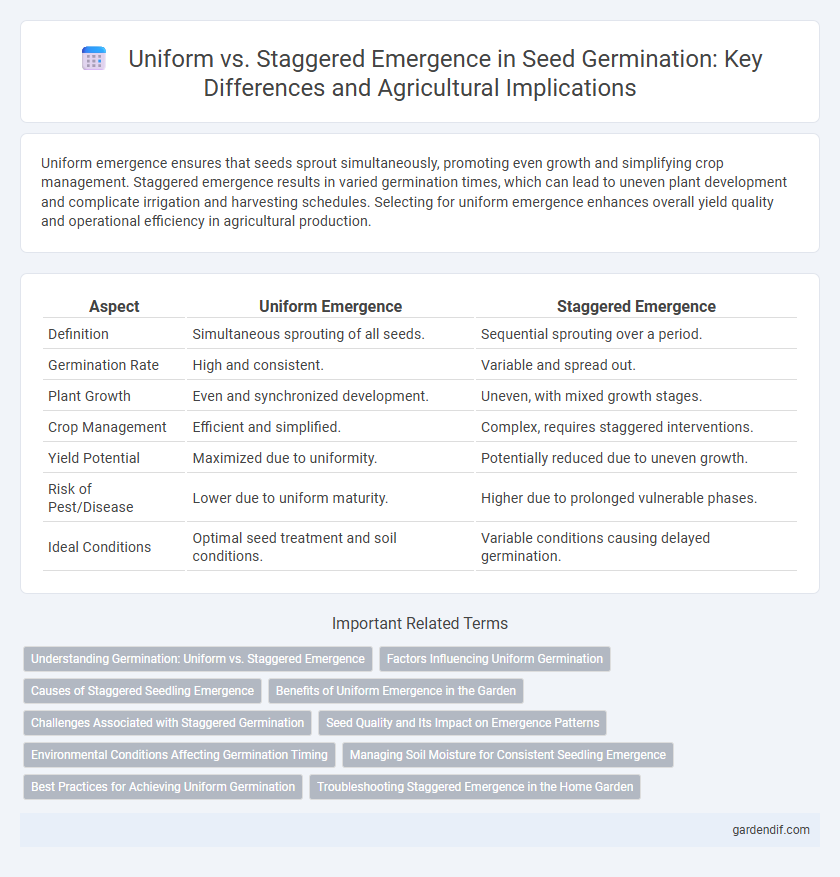
Uniform emergence vs Staggered emergence Illustration
Uniform emergence ensures that seeds sprout simultaneously, promoting even growth and simplifying crop management. Staggered emergence results in varied germination times, which can lead to uneven plant development and complicate irrigation and harvesting schedules. Selecting for uniform emergence enhances overall yield quality and operational efficiency in agricultural production.
Table of Comparison
| Aspect | Uniform Emergence | Staggered Emergence |
|---|---|---|
| Definition | Simultaneous sprouting of all seeds. | Sequential sprouting over a period. |
| Germination Rate | High and consistent. | Variable and spread out. |
| Plant Growth | Even and synchronized development. | Uneven, with mixed growth stages. |
| Crop Management | Efficient and simplified. | Complex, requires staggered interventions. |
| Yield Potential | Maximized due to uniformity. | Potentially reduced due to uneven growth. |
| Risk of Pest/Disease | Lower due to uniform maturity. | Higher due to prolonged vulnerable phases. |
| Ideal Conditions | Optimal seed treatment and soil conditions. | Variable conditions causing delayed germination. |
Understanding Germination: Uniform vs. Staggered Emergence
Uniform emergence in germination ensures that seeds sprout simultaneously, leading to consistent plant development and optimized resource use across the growing area. In contrast, staggered emergence results from variable seed dormancy or environmental conditions, causing uneven growth stages that can complicate management and reduce overall yield. Recognizing factors influencing uniformity, such as seed quality and soil temperature, is essential for achieving synchronized germination and maximizing crop performance.
Factors Influencing Uniform Germination
Uniform germination is influenced by optimal seed quality, consistent moisture levels, and precise temperature control, all of which promote synchronized seedling development. Seed treatment techniques such as priming and scarification enhance uniformity by improving water absorption and breaking seed dormancy. Soil conditions including aeration, pH balance, and nutrient availability also play critical roles in achieving uniform emergence across the planting area.
Causes of Staggered Seedling Emergence
Uneven soil moisture, temperature fluctuations, and variable seed quality contribute significantly to staggered seedling emergence during germination. Differences in seed dormancy and depth of planting also affect the timing of root and shoot development, causing asynchronous growth. Pathogen presence and soil compaction further hinder uniform emergence by delaying or inhibiting seedling establishment.
Benefits of Uniform Emergence in the Garden
Uniform emergence in the garden ensures synchronized seedling growth, leading to efficient nutrient and water use. This consistency reduces competition among plants and simplifies pest and disease management. Gardeners benefit from predictable crop development, resulting in higher yields and easier harvesting.
Challenges Associated with Staggered Germination
Staggered germination presents significant challenges in crop management, including uneven plant development that complicates irrigation, fertilization, and pest control schedules. This variability in emergence timing increases vulnerability to environmental stressors and reduces overall yield consistency. Managing staggered germination requires adaptive strategies to mitigate its impact on crop uniformity and harvest efficiency.
Seed Quality and Its Impact on Emergence Patterns
Seed quality directly influences germination uniformity, as high-vigor seeds promote uniform emergence by ensuring synchronized growth and development. Poor seed quality often results in staggered emergence due to variable germination rates and impaired seedling vigor, leading to uneven crop stands. Uniform emergence improves overall yield potential and resource efficiency by minimizing intra-crop competition and facilitating timely crop management practices.
Environmental Conditions Affecting Germination Timing
Uniform emergence occurs when environmental conditions such as consistent soil moisture, optimal temperature, and adequate light exposure create a stable setting for seed germination, promoting simultaneous sprouting. Staggered emergence arises from variable factors like fluctuating temperatures, uneven water availability, or inconsistent light, causing seeds to germinate at different times. Soil pH, oxygen levels, and microbial activity also influence the timing and uniformity of seedling emergence by affecting seed metabolism and dormancy breakage.
Managing Soil Moisture for Consistent Seedling Emergence
Managing soil moisture is critical for achieving uniform emergence, as consistent moisture levels promote synchronized seed germination and root development. Staggered emergence often results from uneven soil moisture, leading to varied seedling vigor and growth stages within a crop. Implementing precise irrigation techniques and monitoring soil water potential ensure optimal moisture retention, enhancing uniform seedling emergence and improving overall crop establishment.
Best Practices for Achieving Uniform Germination
Achieving uniform germination requires selecting high-quality, viable seeds combined with optimal soil temperature and moisture conditions tailored to the specific crop species. Employing precise seed spacing and consistent planting depth enhances root development and synchronizes seedling emergence. Regular monitoring and timely irrigation prevent uneven soil drying, promoting a consistent and uniform emergence across the planting area.
Troubleshooting Staggered Emergence in the Home Garden
Troubleshooting staggered emergence in the home garden requires addressing inconsistent soil moisture and temperature fluctuations, which are key factors causing uneven seed germination. Ensuring uniform seed depth and spacing promotes synchronized root development and nutrient uptake, enhancing overall plant vigor. Implementing mulch or shade techniques can stabilize microclimate conditions, reducing stress and supporting more uniform seedling emergence.
Uniform emergence vs Staggered emergence Infographic

 gardendif.com
gardendif.com